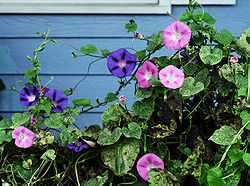Ipomoea purpurea
| Ipomoea purpurea | |
|---|---|
 | |
| Scientific classification | |
| Kingdom: | Plantae |
| (unranked): | Angiosperms |
| (unranked): | Eudicots |
| (unranked): | Asterids |
| Order: | Solanales |
| Family: | Convolvulaceae |
| Genus: | Ipomoea |
| Species: | I. purpurea |
| Binomial name | |
| Ipomoea purpurea (L.) Roth[1] | |
Ipomoea purpurea, the Purple, Tall, or Common Morning Glory, is a species in the genus Ipomoea, native to Mexico and Central America. Like all morning glories the plant entwines itself around structures, growing to a height of 2–3 m tall. The leaves are heart-shaped and the stems are covered with brown hairs. The flowers are trumpet-shaped, predominantly blue to purple or white, 3–6 cm diameter. [2]
Habitats
The plant is predisposed to moist and rich soil, but can be found growing in a wide array of soil types.[3] It is naturalized throughout warm temperate and subtropical regions of the world. Although it is often considered a noxious weed, Ipomoea purpurea is also grown for its beautiful purple and white flowers and has many cultivars. Common cultivars include I. purpurea 'Crimson Rambler' (red-violet blossoms with white throats), 'Grandpa Ott's,' 'Kniola's Black Knight,' and 'Star of Yelta' (blossoms in varying shades of deep purple with white or pale pink throats) and 'Milky Way' (white blossoms with mauve accents).
Chemistry
The triangular seeds have some history of use as a psychedelic; they, like Ipomoea tricolor contain LSA.[3] Effects are reported to be somewhat similar to those of LSD.[4]
Flower color
Acylated cyanidin glycosides can be isolated from violet-blue flowers of I. purpurea. These anthocyanins were all based on cyanidin 3-sophoroside-5-glucoside, acylated with caffeic acid and/or p-coumaric acid.[5]
Acylated pelargonidin glycosides can be isolated from the red-purple flowers of I. purpurea. The acylated anthocyanins were all based on pelargonidin 3-sophoroside-5-glucoside, acylated with caffeic acid and/or glucosylcaffeic acid.[6]
Gallery
-

Light blue I. purpurea
-

Pink Ipomoea purpurea
-

Pink Ipomoea purpurea close-up
-

Ipomoea purpurea in Loganville, Georgia
-

Pink Ipomoea purpurea
-

Purple Ipomoea purpurea close-up
-

Purple Ipomoea purpurea close-up
-

Scanning electron micrograph of Ipomoea purpurea pollen.
See also
Notes
- ↑ USDA Plants Profile
- ↑ Germplasm Resources Information Network: Ipomoea purpurea
- ↑ 3.0 3.1 Richard H. Uva, Joseph C. Neal and Joseph M. Ditomaso, Weeds of The Northeast, (Ithaca, NY: Cornell University Press, 1997), Pp. 214-217
- ↑ Charles Savage, Willis W. Harman and James Fadiman, Ipomoea purpurea: A Naturally Occurring Psychedelic
- ↑ Acylated cyanidin glycosides in the violet-blue flowers of Ipomoea purpurea. Norio Saito, Fumi Tatsuzawa, Kyoko Yoda, Masato Yokoi, Kichiji Kasahara, Shigeru Iida, Atsushi Shigihara and Toshio Honda, Phytochemistry, November 1995, Volume 40, Issue 4, Pages 1283–1289, doi:10.1016/0031-9422(95)00369-I
- ↑ Acylated pelargonidin glycosides in red-purple flowers of Ipomoea purpurea. Norio Saito, Fumi Tatsuzawa, Masato Yokoi, Kichiji Kasahara, Shigeru Iida, Atsushi Shigihara and Toshio Honda, Phytochemistry, December 1996, Volume 43, Issue 6, Pages 1365–1370, doi:10.1016/S0031-9422(96)00501-8
External links
| Wikimedia Commons has media related to Ipomoea purpurea. |